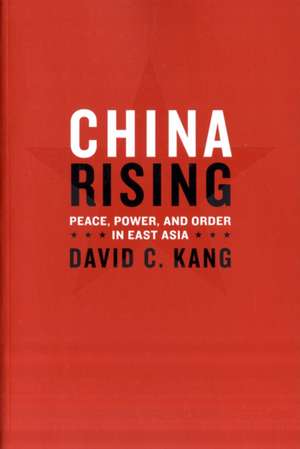China Rising – Peace, Power and Order in East Asia
Autor David Kangen Limba Engleză Paperback – 28 ian 2010
Preț: 248.21 lei
Nou
Puncte Express: 372
Preț estimativ în valută:
47.53€ • 49.03$ • 39.39£
47.53€ • 49.03$ • 39.39£
Carte tipărită la comandă
Livrare economică 20 februarie-06 martie
Preluare comenzi: 021 569.72.76
Specificații
ISBN-13: 9780231141895
ISBN-10: 0231141890
Pagini: 296
Dimensiuni: 153 x 227 x 18 mm
Greutate: 0.39 kg
Editura: Columbia University Press
ISBN-10: 0231141890
Pagini: 296
Dimensiuni: 153 x 227 x 18 mm
Greutate: 0.39 kg
Editura: Columbia University Press
Notă biografică
David C. Kang is a professor of international relations and business at the University of Southern California. He is the author of Crony Capitalism: Corruption and Development in South Korea and the Philippines and, with Victor Cha, Nuclear North Korea: A Debate on Engagement Strategies. He is a regular media commentator, and has published opinion pieces in the New York Times and the Washington Post. Kang is also a frequent consultant to both multinational corporations and U.S. government agencies, including the CIA, National Intelligence Council, and State Department.
Cuprins
List of Illustrations
Acknowledgments
Part I: The Puzzle and the Argument
1. The Puzzle and China's Amazing Rise
2. Power, Interests, and Identity in East Asian International Relations, 1300 to 1900
3. Describing East Asia: Alignment Strategies Toward China
Part II: East Asia Responds to China
4. China: Identity, Sovereignty, and Taiwan
5. South Korea: Embracing Interdependence in Search of Security
6. Southeast Asia: Accommodating China's Rise
7. Japan: A Normal Identity
Part III: East Asia and the United States
8. The Role of the United States in East Asia
9. Conclusions and Implications
Notes
Selected Bibliography
Index
Acknowledgments
Part I: The Puzzle and the Argument
1. The Puzzle and China's Amazing Rise
2. Power, Interests, and Identity in East Asian International Relations, 1300 to 1900
3. Describing East Asia: Alignment Strategies Toward China
Part II: East Asia Responds to China
4. China: Identity, Sovereignty, and Taiwan
5. South Korea: Embracing Interdependence in Search of Security
6. Southeast Asia: Accommodating China's Rise
7. Japan: A Normal Identity
Part III: East Asia and the United States
8. The Role of the United States in East Asia
9. Conclusions and Implications
Notes
Selected Bibliography
Index
